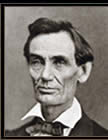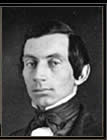An Analytical Biography of a Great Mind- by Edward J. Kempf
- PART I
- PREFACE
- INTRODUCTION
- Chapter I - Lincoln's Physical Costitution
- Hereditary Determination
- Hypersensitive Hypokinetic Constitution
- Meaning of Facial Asymmetries
- Fracture of Skull and Injury of Brain in Boyhood
- Diagnosis of Cerebral Lesion
- Diplopia and Eyestrain
- Borglum's Interpretation of Lincoln's Face
- Enigmatical Character of Facial Expression
- Preference for Photographs of Right Side of Face
- References
Borgulums interpretation of lincolns face
Gutzon Borglum, sculptor of the great marble head of Lincoln in the
Capitol rotunda at Washington, made extensive comparative measurements
of the photographs and masks of Lincoln, and studies of his notes, letters,
speeches and life history before attempting the
portrait.
In an essay on Lincoln, Borglum gave interpretations of the relative
meanings of the right and left sides of his face as indicated by its
lines and measurements. He saw the greater strength of functioning of
the right side relative to the left. The lines around the right eye and
its direct convergence showed that it was more active, that is, dominant,
and that he naturally thought
and planned with the visualized imagery
of this eye. He was "naturally a merry soul changed by sadness." The
lines around Lincoln's mouth and its displacement towards the right indicated
that "he smiled very, very often when his nature took no part in
it."
Borglum noticed that the tip of the nose was also turned toward the right but he did not give any particular significance to this. However, he saw that the left eye was "wide open" and out of focus, "indecisive," "noncommittal and dreamy." The left side of the face seemed "primitive," "immature" and "unfinished." Its weak expression was "sad and undetermined" in contrast to the determined strength of the right side. The left brow was "anxious, ever slightly elevated and concerned."* Written on his face was "humor, pathos, half-smile, half-sadness; half-anger, half-forgiveness, half-determination, half-pause; .... a dual Nature struggling with a dual problem delivering a single result."
Borglum's description of Lincoln's face is the most careful and thorough given heretofore by any artist or biographer, but he made no attempt to find why the left side was characterless, weak and undeveloped and the right side expressed the real personality and state of mind of Lincoln.

